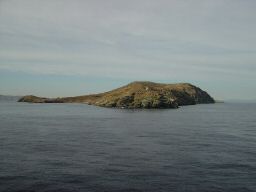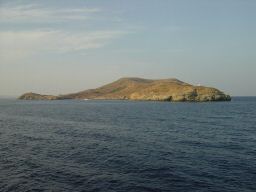Makronisos: The Island of Exile
When one sails from Lavrion to the island of Kea much of the journey is spent going around a long barren island where you can see the ruins of some old buildings and little else besides rocks. This is the island of Makronisos, Greece's equivelant of Alkatraz. But these were not hardened criminals, murderers and thugs. Makronisos was where many people who had fought to liberate Greece from the Germans during World War Two, met their fate at the hands of their countrymen, tortured and killed because of their political beliefs. The men who lived and died here were the first victims of the Cold War.
In October 1944 the German army which had been occupying Greece retreated. Their stay in Greece was not a pleasant one, for even though the Greek government and the army had themselves retreated from Greece when the Germans first arrived, the Greek resistance, which was predominately communist, harassed the occupiers from their camps in the mountains as well as in the cities. When the country was liberated, the Greek government returned with George Papandreau (father of Andreas) as Prime Minister sharing power with the left in a government of national unity.
Unfortunately for the left it had been decided beforehand in Yalta by the leaders of the USA, Great Britain and The Soviet Union, when they divided up Europe, that Greece was not going to be allowed to fall under the influence of the communists. The possibility that the left would have any place at all in the Greek political system was disturbing to the leaders of the free world, despite the fact that the left had been the main resistance against the Nazis. General Scoby under orders from Winston Churchill initiated political intrigues against the communists and forced them to resign from the government. On December 3rd a peaceful demonstration in Syntagma Square was fired upon by police snipers which resulted in the deaths of innocent civilians. This led to the Dekembriana, the December uprising which lasted until January 5th.
With the treaty of Varkiza in February the communists turned in their weapons which made them easy prey for the right-wing criminal militias, who had been colaborators with the Nazis but were now backed by the British, who hunted down members of the resistance and their families. The first elections were held in March of 1946 but was boycotted by the communist party, a fatal mistake because from that point on they were outsiders and non-participants in the Greek political system.
Since the treaty of Varkiza the atrocities committed by the right against the left rivaled the crimes of the Nazis. There were 1289 murdered, 31,632 tortured, 30,000 imprisoned and many raped as well as the looting and destruction of property. So in 1946 while the rest of Europe was celebrating the peace after World War Two and trying to get back on their feet, Greece had entered another period of misery as Civil War erupted with the British backing the most reactionary of the Greeks. The leftist parties of the KKE, ELAS and EPON were outlawed. Military tribunals were set up all over the country. Thousands of leftists were executed. 50,000 were imprisoned and tens of thousands were exiled to remote islands.
In 1946 under a government directive from
Prime Minister Sofoulis, communists of draft age were sent
to the barren island of Makronisos off the coast of Attika, between
the town of Lavrion and the island of Kea. The future prime minister Kannelopoulos (who
was overthrown by the Junta)
had called Makronisos ‘Greece’s new Parthenon’. In much later years, he
regretted having said this.
The plan was to rehabilitate
these 'bad' Greeks into model citizens. Despite the fact that they
had participated in the national resistance against the German occupation
they were considered 'traitors' and 'enemies of the state'.
Their rehabilitation was called the Baptistry of Siloam and consisted of torture, living in tents in extreme hot or cold weather, hunger and thirst, solitary confinement, threats and brainwashing. When their spirit was broken they could sign a declaration admitting wrongdoing and asking for forgiveness. They were then sent to the front lines to fight against their comrades. Those who refused to sign were tried in a tribunal court, executed by firing squad or locked up in the Military Prison of Makronisos. The vast majority were left on the island to be tortured and abused.
In the northern part of Makronisos civilians
and officers were held in what was called D Battalion. These were
groups of 500 men crowded fourteen to a tent and isolated from other
groups by a fifteen foot high barbed-wire fence. A Battalion was
worse and prisoners were beaten and tortured with bats, iron bars
and bamboo canes resulting in broken bones, spinal injury, blinding,
psychological trauma and death for thousands of prisoners. This went
on even after the Civil war ended in 1949. As time wore on, many fighters
from the left who only wanted to return home
and recommence their lives, found that they could not go back to their
villages for fear of reprisals. In 1949 the communists retreating to the Eastern
block countries issued the infamous edict that all fighters will remain ready to re-attack
(‘to oplo para podas’). This of course was false but gave
the right wing governments the excuse to prosecute all leftist sympathizers(not
only communists) relentlessly. And many of course ended up in
Makronisos.
The military junta that ruled Greece
repopulated the island with inmates during the 1967-73
period.
Now Makronisos is deserted and the torture and cruelty that took place half a century ago is an almost forgotten memory except by those who lived through it. While the Greek Islands usually make us think of summer, sun, swimming and nights in the tavernas, Makronisos shows us there is another side and that man's inhumanity to his fellow man can turn any heaven into a hell. Like the concentration camps in Poland and Germany the island of Makronisos should be open to the public with photos and descriptions of what went on there in those shameful days, if for no other reason so that they will never be repeated.
Perhaps the saddest thing is that the later history of Makronissos has eclipsed the island's significance in ancient times, for Macronissos was the place of refuge for the beautiful Helen when the Trojan War broke out.



